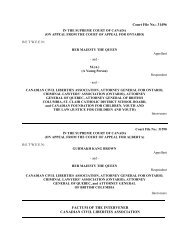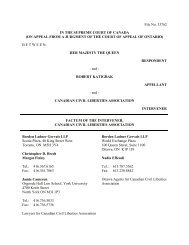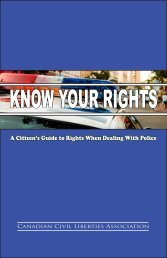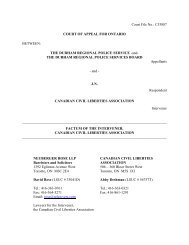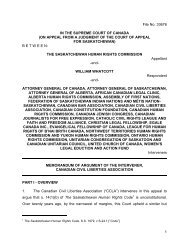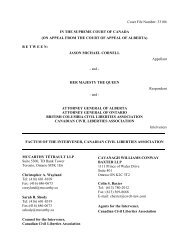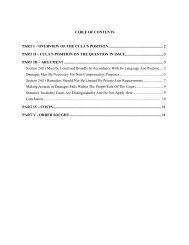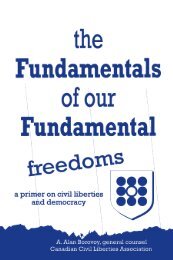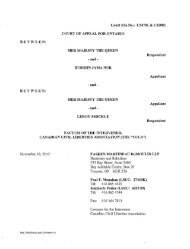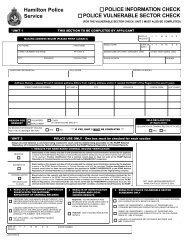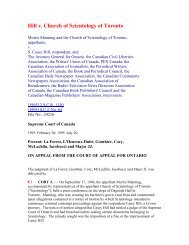Read CCLA's factum before the Saskatchewan Court of Appeal
Read CCLA's factum before the Saskatchewan Court of Appeal
Read CCLA's factum before the Saskatchewan Court of Appeal
- No tags were found...
Create successful ePaper yourself
Turn your PDF publications into a flip-book with our unique Google optimized e-Paper software.
C.A. No. 678 <strong>of</strong> 2003BETWEEN:IN THE COURT OF APPEAL FOR SASKATCHEWAN(ON APPEAL FROM THE COURT OF QUEEN’S BENCH)HUGH OWENSAPPELLANT- and -SASKATCHEWAN HUMAN RIGHTS COMMISSIONRESPONDENT- and -CANADIAN CIVIL LIBERTIES ASSOCIATIONINTERVENER- and -CANADIAN RELIGIOUS FREEDOM ALLIANCEINTERVENERFACTUM OF THE INTERVENER,CANADIAN CIVIL LIBERTIES ASSOCIATIONAndrew K. LokanLouis A. BrownePaliare Roland Rosenberg Rothstein LLP McDougall Gauley LLP250 University Avenue, Suite 501 700 Royal Bank Bldg.Toronto, ON M5H 3E52010 11th Ave.Tel: (416) 646-4324Regina, SK S4P 0J3Fax: (416) 646-4323 Tel: (306) 565-5166E-mail: andrew.lokan@paliareroland.com Fax: (306) 359-0785Counsel for <strong>the</strong> Intervener,Canadian Civil Liberties Association
TO:Hugh Owens#5 – 4100 Rettalack StreetRegina, SK S4S 3C3AppellantAND TO: Milton Woodard, Q.C.<strong>Saskatchewan</strong> Human Rights Commission8 th Floor, 122 Third Avenue NorthSaskatoon, SK S7K 2H6Counsel for <strong>the</strong> RespondentAND TO: Tom SchuckNimegeers, Schuck, Wormsbecker & Bobbitt319 Souris Avenue N.E. (P.O. Box 8)Weyburn, SK S4H 2J8Counsel for <strong>the</strong> Intervener, Canadian Religious Freedom Alliance
TABLE OF CONTENTSPART I - INTRODUCTION 1PART ll - JURISDICTION AND STANDARD REVIEW 3PART III - FACTS 3PART IV - POINTS IN ISSUE 6PART V - ARGUMENT 6PAGEA. Section 14(1) must be interpreted narrowly inaccordance with <strong>the</strong> Charter 6B. The Order is not justified under section 1 <strong>of</strong> <strong>the</strong> Charter 15C. The Board Erred in Failing to Make Required Findings 17Conclusion 19PART VI - RELIEF REQUESTED 20PART VII - TABLE OF AUTHORITIES 21Cases 21Secondary Sources 21
1PART I - INTRODUCTION1. This case presents an important and novel legal issue concerning <strong>the</strong>interpretation and application <strong>of</strong> Section 14(1) <strong>of</strong> <strong>the</strong> <strong>Saskatchewan</strong> Human RightsCode (<strong>the</strong> “Code”). This <strong>Court</strong> must determine whe<strong>the</strong>r <strong>the</strong> Appellant’s advertisementfor a bumper sticker citing Biblical passages to convey disapproval <strong>of</strong> homosexualityconstitutes impermissible hate speech, or is expression protected by s.2(a) and (b) <strong>of</strong><strong>the</strong> Charter and ss. 5 and 14(2) <strong>of</strong> <strong>the</strong> Code. The Canadian Civil Liberties Association(“CCLA”) submits that <strong>the</strong> advertisement is protected expression under both <strong>the</strong> Charterand <strong>the</strong> Code, and that <strong>the</strong> Board <strong>of</strong> Inquiry (<strong>the</strong> “Board”) and <strong>Court</strong> below erred inruling that this expression was prohibited under s.14(1).2. The CCLA is Canada’s largest and most active public interest organizationdevoted to protecting rights and freedoms. The CCLA has repeatedly argued inlegislative and court submissions that discrimination on <strong>the</strong> basis <strong>of</strong> sexual orientation isunjust and unfair. On <strong>the</strong> difficult balance between <strong>the</strong> equality rights <strong>of</strong> gays andlesbians and <strong>the</strong> fundamental freedoms <strong>of</strong> religious groups and individuals, <strong>the</strong> CCLAdoes not a priori favour one side or ano<strong>the</strong>r, but ra<strong>the</strong>r seeks to determine in each case<strong>the</strong> approach that best accords with civil liberties principles. For example, <strong>the</strong> CCLAtook <strong>the</strong> following positions in recent cases:• In Trinity Western University v. British Columbia Council <strong>of</strong> Teachers, 1 <strong>the</strong>CCLA supported a private university's claim to be accredited forcertification <strong>of</strong> its graduates as teachers eligible to teach in <strong>the</strong> publicschool system, despite <strong>the</strong> fact that <strong>the</strong> university's religiously-based code<strong>of</strong> conduct likely excluded gays and lesbians;• In Chamberlain v. The Board <strong>of</strong> Trustees <strong>of</strong> School District #36 (Surrey), 2<strong>the</strong> CCLA opposed a public school board's decision (purportedly made onreligious grounds) not to approve, for a school curriculum, books depictingsame-sex parents;• In Brockie v. Ontario Human Rights Commission, 3 <strong>the</strong> CCLA supported acommercial printer's right to refuse service to <strong>the</strong> Gay and LesbianArchives on religious grounds; and1 [2001] S.C.R. 772.2 [2002] 4 S.C.R. 710.3 [2002] O.J. No. 2375 (Div. Ct.).
2• In Reference re Same-Sex Marriage, 4 <strong>the</strong> CCLA argued that <strong>the</strong> extension<strong>of</strong> civil marriage to same-sex couples was required under s.15 and did notper se infringe <strong>the</strong> freedom <strong>of</strong> religion <strong>of</strong> objecting churches; but thatbroad protection should be extended to those who did not wish to lend<strong>the</strong>ir assistance to same-sex marriage ceremonies on religious orconscientious grounds.3. The CCLA does not intervene in this appeal to defend <strong>the</strong> merits <strong>of</strong> <strong>the</strong>Appellant’s views. Indeed, <strong>the</strong> CCLA explicitly rejects such views. Ra<strong>the</strong>r, <strong>the</strong> CCLAseeks to ensure that <strong>the</strong> fundamental rights to freedom <strong>of</strong> expression, conscience, andreligion are given both a broad interpretation and a robust application.4. The CCLA has no doubt that many (or perhaps most) Canadians would find <strong>the</strong>Appellant’s message to be unpleasant and extreme. However, <strong>the</strong> CCLA submits thatgenerally, <strong>the</strong> proper response to speech that is <strong>of</strong>fensive, distasteful, or upsetting iscounter-speech. Indeed, counter-speech was successful in resolving <strong>the</strong> underlyingdispute in this case, as <strong>the</strong> Star Phoenix newspaper, in response to vocal protests,voluntarily agreed not to carry advertisements like those <strong>of</strong> <strong>the</strong> Appellant’s in <strong>the</strong> future. 5This decision was made <strong>before</strong> <strong>the</strong> Board issued its order prohibiting <strong>the</strong> newspaperfrom carrying <strong>the</strong> advertisement.5. When <strong>of</strong>fensive speech is subject to legal prohibition, serious dangers arise: first,expression that is fundamental to <strong>the</strong> rigorous debate and individual decision-makingthat underlies a functioning democracy may be prohibited; second, such prohibitionscast a chill over all future speakers, leading to self-censorship. Those dangers aremagnified when <strong>the</strong> speech in issue concerns matters <strong>of</strong> religion or morality. Theproper interpretation <strong>of</strong> <strong>the</strong> Charter and <strong>the</strong> Code lead to <strong>the</strong> conclusion that <strong>the</strong> appealshould be allowed.4 [2004] 3 S.C.R. 698.5 Decision <strong>of</strong> <strong>the</strong> Board <strong>of</strong> Inquiry dated June 15, 2001 (“Decision <strong>of</strong> <strong>the</strong> Board”), p. 7.
3PART II - JURISDICTION AND STANDARD OF REVIEW6. This <strong>Court</strong> has jurisdiction pursuant to Section 32(5) <strong>of</strong> <strong>the</strong> Code.7. The overall standard <strong>of</strong> review in this case is correctness, as conceded by <strong>the</strong>Respondent. 6 However, contrary to <strong>the</strong> Respondent’s submission, <strong>the</strong>re is no significantelement <strong>of</strong> fact-finding in <strong>the</strong> Board’s decision that requires <strong>the</strong> basic standard <strong>of</strong>correctness to be tempered in <strong>the</strong> circumstances <strong>of</strong> this case. The issues upon which<strong>the</strong> Respondent would have this <strong>Court</strong> defer are <strong>the</strong> characterization <strong>of</strong> <strong>the</strong> Appellant’smessage, and “what <strong>the</strong> Board perceived as hatred and ridicule”. With respect, this isnot a factually complex case that depends upon subtle contextual factors. The nature <strong>of</strong><strong>the</strong> Appellant’s message, whe<strong>the</strong>r it is protected by s.2(a) and (b) <strong>of</strong> <strong>the</strong> Charter and s.5<strong>of</strong> <strong>the</strong> Code, and whe<strong>the</strong>r it falls within s.14 <strong>of</strong> <strong>the</strong> Code are all primarily questions <strong>of</strong>interpretation. The correctness standard applies to <strong>the</strong>se questions. 7PART III - FACTS8. The CCLA takes no position on any contested issue <strong>of</strong> fact. The CCLA bases itssubmissions on <strong>the</strong> facts as described in <strong>the</strong> Board and <strong>Court</strong> below.9. The narrative facts <strong>of</strong> this case are simple. The Appellant submitted anadvertisement for <strong>the</strong> sale <strong>of</strong> bumper stickers to <strong>the</strong> Star Phoenix (<strong>the</strong> “Advertisement”),which was published on a single occasion on June 30, 1997. The Advertisementconsisted <strong>of</strong> four passages from <strong>the</strong> Bible in red ink, followed by an equal sign and twostick men holding hands inside a red circle with a line through <strong>the</strong> stick men. 86 Factum <strong>of</strong> <strong>the</strong> Respondent, 26.7 Trinity Western University v. British Columbia College <strong>of</strong> Teachers, [2001] 1 S.C.R. 772, 805(“The public dimension <strong>of</strong> religious freedom and <strong>the</strong> right to determine’s one moral conduct havebeen . . . considered to be legal issues. The accommodation <strong>of</strong> beliefs is a legal question”); Rossv. New Brunswick School District No. 15, [1996] 1 S.C.R. 825, 32 (holding that no deference needbe given to human rights tribunal’s analysis <strong>of</strong> Charter values); Toronto (City) v. C.U.P.E. Local 79,[2003] 3 S.C.R. 77, 117 per LeBel J. (“Certain fundamental legal questions -- for instanceconstitutional and human rights questions and those involving civil liberties . . . typically fall to bedecided on <strong>the</strong> correctness standard”).8 Decision <strong>of</strong> <strong>the</strong> Board, p. 2.
410. The Biblical passages referred to in <strong>the</strong> Advertisement were Romans 1:26,Leviticus 18:22, Leviticus 20:13, and 1 Corinthians 6:9. These passages containvarious comments on <strong>the</strong> morality <strong>of</strong> homosexual acts. Most starkly, Leviticus 20:13provides as follows:If a man lies with a man as one lies with a woman, both <strong>of</strong> <strong>the</strong>m havedone what is detestable. They must be put to death; <strong>the</strong>ir blood will be on<strong>the</strong>ir own heads. 911. The Board heard evidence <strong>of</strong> a number <strong>of</strong> subjective interpretations <strong>of</strong> <strong>the</strong>Advertisement and <strong>the</strong> Biblical passages <strong>the</strong>mselves, which were far from unanimous in<strong>the</strong> meanings attributed to <strong>the</strong>m. 10 The Board also heard evidence that <strong>the</strong>re werevarying degrees <strong>of</strong> acceptance <strong>of</strong> homosexuality in various religions. The Boardcommented that “[m]uch <strong>of</strong> this evidence, however, is not relevant to <strong>the</strong> issues <strong>before</strong><strong>the</strong> Board, o<strong>the</strong>r than to establish <strong>the</strong> fact that homosexuality and its acceptance is anissue in many religions and may form part <strong>of</strong> an individual’s religious beliefs.” 1112. The Board found that <strong>the</strong>re was “no question” that <strong>the</strong> Appellant “believed that hewas publicly expressing his honestly held religious belief as it related to hisinterpretation <strong>of</strong> <strong>the</strong> Bible and its discussion <strong>of</strong> homosexuality”. 1213. However, <strong>the</strong> Board found that <strong>the</strong> Advertisement infringed s.14 <strong>of</strong> <strong>the</strong> Code.The Board prohibited <strong>the</strong> Appellant from displaying <strong>the</strong> Advertisement, and ordered <strong>the</strong>Appellant and <strong>the</strong> Star Phoenix to pay <strong>the</strong> complainants $1500 each in damages. 1314. The Board characterized <strong>the</strong> Advertisement in <strong>the</strong> following terms:In this advertisement <strong>the</strong>re is a pictorial <strong>of</strong> two stick figures holding hands,and <strong>the</strong>re is a circle and slash superimposed over <strong>the</strong> image <strong>of</strong> <strong>the</strong> twostick figures. There are also four references to Bible passages with an“equals” sign between <strong>the</strong> pictorial and <strong>the</strong> passages. The pictorial <strong>of</strong> <strong>the</strong>two stick figures is a more neutral presentation than <strong>the</strong> caricature which9 Decision <strong>of</strong> <strong>the</strong> Board, p. 10-11.10 Decision <strong>of</strong> <strong>the</strong> Board, p. 5-8.11 Decision <strong>of</strong> <strong>the</strong> Board, p. 6-8.12 Decision <strong>of</strong> <strong>the</strong> Board, p. 13.13 Decision <strong>of</strong> <strong>the</strong> Board, p. 15-16.
5were [sic] <strong>before</strong> <strong>the</strong> <strong>Court</strong> <strong>of</strong> <strong>Appeal</strong> in <strong>the</strong> Bell case. The <strong>Court</strong> <strong>of</strong><strong>Appeal</strong> determined that <strong>the</strong> circle and slash superimposed over <strong>the</strong>images in that case was <strong>the</strong> universal symbol for forbidden, not allowed ornot wanted.In <strong>the</strong> within case, while <strong>the</strong> stick figures are more neutral, <strong>the</strong> biblicalpassages… are as follows: [quotation omitted]Having reviewed all <strong>of</strong> <strong>the</strong> evidence, <strong>the</strong> Board accepts that <strong>the</strong> universalsymbol for forbidden, not allowed or not wanted, consisting <strong>of</strong> a circle witha slash through it, may not itself communicate hatred. However, whencombined with <strong>the</strong> passages from <strong>the</strong> Bible, <strong>the</strong> Board finds that <strong>the</strong>advertisement would expose or tend to expose homosexuals to hatred orridicule, or may o<strong>the</strong>rwise affront <strong>the</strong>ir dignity on <strong>the</strong> basis <strong>of</strong> <strong>the</strong>ir sexualorientation. It is a combination <strong>of</strong> both <strong>the</strong> symbol and <strong>the</strong> biblicalreferences which have lead [sic] to this conclusion…The use <strong>of</strong> <strong>the</strong> circle and slash combined with <strong>the</strong> passages <strong>of</strong> <strong>the</strong> Bibleherein make <strong>the</strong> meaning <strong>of</strong> <strong>the</strong> advertisement unmistakable. It is clearthat <strong>the</strong> advertisement is intended to make <strong>the</strong> group depicted appear tobe inferior or not wanted at best. When combined with <strong>the</strong> Biblicalquotations, <strong>the</strong> advertisement may result in a far stronger meaning. It isobvious that certain <strong>of</strong> <strong>the</strong> Biblical quotations suggest more direconsequences and <strong>the</strong>re can be no question that <strong>the</strong> advertisement canobjectively be seen as exposing homosexuals to hatred or ridicule. 1415. The Appellant’s appeal to <strong>the</strong> <strong>Court</strong> <strong>of</strong> Queen’s Bench was dismissed. JusticeBarclay, after reviewing <strong>the</strong> facts and <strong>the</strong> Board’s decision, found as follows:In my view <strong>the</strong> Board was correct in concluding that <strong>the</strong> advertisement canobjectively be seen as exposing homosexuals to hatred or ridicule. When<strong>the</strong> use <strong>of</strong> <strong>the</strong> circle and slash is combined with <strong>the</strong> passages <strong>of</strong> <strong>the</strong> Bible,it exposes homosexuals to detestation, vilification and disgrace. In o<strong>the</strong>rwords, <strong>the</strong> Biblical passage which suggest [sic] that if a man lieswith a man <strong>the</strong>y must be put to death exposes homosexuals tohatred. 15 [emphasis added]14 Decision <strong>of</strong> <strong>the</strong> Board, p. 10-12.15 Decision <strong>of</strong> Barclay J., Owens v. <strong>Saskatchewan</strong> (Human Rights Commission), [2002] S.J. No.732 (Q.B.), 21.
7what <strong>the</strong> law prohibits. The law must be construed, and interpretations thatmay minimize <strong>the</strong> alleged overbreadth must be explored … 2019. The Supreme <strong>Court</strong> has frequently remarked on <strong>the</strong> importance <strong>of</strong> freedom <strong>of</strong>expression, noting that “[i]t makes possible our liberty, our creativity and ourdemocracy.” 21 In Edmonton Journal v. Alberta (AG), 22 <strong>the</strong> <strong>Court</strong> stated as follows:It is as difficult to imagine a guaranteed right more important to ademocratic society than freedom <strong>of</strong> expression. Indeed, a democracycannot exist without that freedom to express new ideas and put forwardopinions about <strong>the</strong> functioning <strong>of</strong> public institutions. The concept <strong>of</strong> freeand uninhibited speech permeates all truly democratic societies andinstitutions. The vital importance <strong>of</strong> <strong>the</strong> concept cannot beoveremphasized. . . . It seems that <strong>the</strong> rights enshrined in s. 2(b) should<strong>the</strong>refore only be restricted in <strong>the</strong> clearest <strong>of</strong> circumstances.20. If <strong>the</strong> purposes <strong>of</strong> protecting freedom <strong>of</strong> expression are to be met, freedom <strong>of</strong>expression must be given a broad interpretation. 23 The guarantee found in s. 2(b)applies even to speech that is regarded by <strong>the</strong> public “as wrong or false” 24 or“<strong>of</strong>fensive” 25 Indeed, as this <strong>Court</strong> aptly noted in <strong>Saskatchewan</strong> (Human RightsCommission) v. Bell, 26 “<strong>the</strong> very purpose <strong>of</strong> s. 2(b) is to protect expression which is<strong>of</strong>fensive to somebody.”21. In <strong>the</strong> present case, <strong>the</strong> need to protect expression is underlined by <strong>the</strong> religiouscontext. The Appellant was found to be expressing a sincerely held religious belief.Fur<strong>the</strong>rmore, <strong>the</strong> harshest part <strong>of</strong> <strong>the</strong> Appellant’s communication was found in <strong>the</strong> Bibleitself. Justice Barclay found that a Biblical passage cited by <strong>the</strong> Appellant “exposeshomosexuals to hatred”. These facts engage <strong>the</strong> Appellant’s freedom <strong>of</strong> conscienceand religion under <strong>the</strong> Charter. 2720 R. v. Sharpe, [2001] 1 S.C.R. 45, 32.21 R. v. Sharpe, supra, p. 70.22 [1989] 2 S.C.R. 1326, 3 (per Cory, J.).23 Ross, supra at 6024 Zundel, supra, at 752.25 Sharpe, supra, at 70. The only expression that falls outside <strong>the</strong> scope <strong>of</strong> s. 2(b) is violent acts:Zundel, supra, at 753.26 114 D.L.R. (4th) 370, 381 (Sask. C.A.).27 Charter, s. 2(a); Trinity Western University, supra; Ross v. New Brunswick School District No.
822. The Respondent has conceded that s. 14(1) <strong>of</strong> <strong>the</strong> Code and <strong>the</strong> Board’s Orderinfringe <strong>the</strong> fundamental guarantees <strong>of</strong> freedom <strong>of</strong> expression, conscience andreligion, 28 and <strong>the</strong>refore must by justified by reference to section 1 <strong>of</strong> <strong>the</strong> Charter. TheSupreme <strong>Court</strong> has held that “[b]ecause <strong>of</strong> <strong>the</strong> importance <strong>of</strong> <strong>the</strong> guarantee <strong>of</strong> freeexpression . . . any attempt to restrict <strong>the</strong> right must be subjected to <strong>the</strong> most carefulscrutiny.” 2923. In support <strong>of</strong> its argument that <strong>the</strong> breaches are justified, <strong>the</strong> Respondent reliesheavily upon <strong>the</strong> Supreme <strong>Court</strong>’s decision in Taylor and this <strong>Court</strong>’s decision in Bell. 30The CCLA submits that Taylor and Bell are not determinative, for at least four reasons:• First, Taylor was a narrow decision carefully limited by <strong>the</strong> <strong>Court</strong> to its specificcontext.• Second, <strong>the</strong> statutory provision at issue here is broader than that considered inTaylor, containing additional language which was specifically invoked by <strong>the</strong>Board in sustaining <strong>the</strong> complaints.• Third, nei<strong>the</strong>r Taylor nor Bell considered infringements on <strong>the</strong> Charterguarantees <strong>of</strong> both freedom <strong>of</strong> expression and freedom <strong>of</strong> conscience andreligion.• Fourth, <strong>the</strong> Advertisement, <strong>the</strong> gravamen <strong>of</strong> which was <strong>the</strong> citation <strong>of</strong> Biblicalpassages on <strong>the</strong> morality <strong>of</strong> homosexual acts, presents quite different facts thanTaylor or Bell.24. In Taylor, <strong>the</strong> Supreme <strong>Court</strong> narrowly upheld <strong>the</strong> constitutionality <strong>of</strong> a provisionin <strong>the</strong> Canadian Human Rights Act that forbade certain kinds <strong>of</strong> hate speech. 31 While<strong>the</strong> CCLA does not agree with <strong>the</strong> result in Taylor, <strong>the</strong> CCLA notes that <strong>the</strong> majorityopinion took pains to point out that it was not approving <strong>of</strong> all hate speech statutes,15, [1996] 1 S.C.R. 825, at 70-73.28 Factum <strong>of</strong> <strong>the</strong> Respondent, 43.29 Sharpe, supra, at 70.30 The Board simply quoted from <strong>the</strong> holding in Bell that Section 14(1) was constitutional, and <strong>the</strong><strong>Court</strong> below pr<strong>of</strong>fered little additional analysis: Decision <strong>of</strong> <strong>the</strong> Board, at 14-15; Decision <strong>of</strong>Barclay J, Owens v. <strong>Saskatchewan</strong> (Human Rights Commission), supra, 22-23. The Respondentargues that Bell “provides a complete answer to this appeal”: Factum <strong>of</strong> <strong>the</strong> Respondent, 45.31 Canada (Human Rights Commission) v. Taylor, [1990] 3 S.C.R. 892.
9regardless <strong>of</strong> purpose, need, or language. Instead, <strong>the</strong> <strong>Court</strong> stated that <strong>the</strong> section 1analysis “requires an approach sensitive to <strong>the</strong> context <strong>of</strong> a given case” 32 and “anappreciation <strong>of</strong> <strong>the</strong> extent to which a restriction <strong>of</strong> <strong>the</strong> activity at issue on <strong>the</strong> facts <strong>of</strong> <strong>the</strong>particular case debilitates or compromises <strong>the</strong> principles underlying <strong>the</strong> broadguarantee <strong>of</strong> freedom <strong>of</strong> expression.” 33 In o<strong>the</strong>r words, an abstract balancing <strong>of</strong> <strong>the</strong>evils <strong>of</strong> hate speech against <strong>the</strong> value <strong>of</strong> free expression will not suffice. Fur<strong>the</strong>r, <strong>the</strong><strong>Court</strong> specifically limited its analysis to speech which is “intended to circulate extremefeelings <strong>of</strong> opprobrium and enmity”—hate speech in its most extreme form. 3425. Section 14(1) <strong>of</strong> <strong>the</strong> Code refers to expression that “ridicules, belittles oro<strong>the</strong>rwise affronts <strong>the</strong> dignity <strong>of</strong> any person,” whereas <strong>the</strong> Canadian Human Rights Actprovision at issue in Taylor was limited to communications “which were likely toexpose… to hatred or contempt” 35 According to a recent comprehensive survey <strong>of</strong>provincial human rights codes, s. 14(1) is <strong>the</strong> broadest such provision in Canada. 36 Theprovision in Taylor was interpreted as applying only to speech involving “unusuallystrong and deep-felt emotions <strong>of</strong> detestation, calumny and vilification”. 37 However, s.14(1) is potentially much broader in scope.26. The CCLA submits that great caution must be exercised in interpreting <strong>the</strong>seadditional words in s. 14(1). Satirists and cartoonists, who are <strong>of</strong>ten effective inachieving political change, depend on humor that may “ridicule, belittle, or affront <strong>the</strong>dignity” <strong>of</strong> a certain political figure, organization, country, or group <strong>of</strong> people. 38 Fur<strong>the</strong>r,an unduly broad interpretation is likely to “chill” members <strong>of</strong> <strong>the</strong> public from participatingin public debates on important political issues, for fear that <strong>the</strong>y may misspeak or bepunished for expressing an unpopular opinion. 39 Section 14(1), if read too broadly,32 Taylor, supra, at 35.33 Taylor, supra, at 48.34 Taylor, supra, at 2.35 Canada (Human Rights Commission) v. Taylor, [1990] 3 S.C.R. 892, at 1.36 Luke McNamara, Negotiating <strong>the</strong> Contours <strong>of</strong> Unlawful Hate Speech: Regulation UnderProvincial Human Rights Laws in Canada, (2005) 38 U.B.C. L. Rev. 1 at 131.37 Taylor, supra, at 61.38 See generally, Nicholas Bakalar, American Satire: An Anthology <strong>of</strong> Writings From ColonialTimes to <strong>the</strong> Present (Plume: 1997); Dustin Griffin, Satire: A Critical Reintroduction (University <strong>of</strong>Kentucky Press, 1995).39 Zundel, supra, at 772: (“The danger is magnified because <strong>the</strong> prohibition affects not only thosecaught and prosecuted, but those who may refrain from saying what <strong>the</strong>y would like to because <strong>of</strong>
10could prohibit a broad range <strong>of</strong> speech that has an important role to play in <strong>the</strong>democratic system.27. In interpreting Section 14(1) in light <strong>of</strong> <strong>the</strong> Charter, “what is at issue is <strong>the</strong> value<strong>of</strong> all speech potentially limited by <strong>the</strong> provision at issue”. 40 If s.14(1) is interpreted toobroadly, a satire on Americans’ love <strong>of</strong> handguns and militarism could be subject toprohibition as “ridiculing” persons based upon <strong>the</strong> protected ground <strong>of</strong> nationality. 41 Ahumorous essay on <strong>the</strong> foibles <strong>of</strong> bachelorhood or <strong>the</strong> bad habits <strong>of</strong> teenagers could“belittle” persons on <strong>the</strong> protected grounds <strong>of</strong> marital status or age. The infamoussuppression <strong>of</strong> Jehovah’s Witnesses in Quebec in <strong>the</strong> 1950s and 1960s, defended byQuebec in part on <strong>the</strong> rationale that <strong>the</strong> Roman Catholic Church should be protectedfrom insult (eventually overturned by <strong>the</strong> Supreme <strong>Court</strong>), could now be justified on <strong>the</strong>ground that such writings “affront <strong>the</strong> dignity” <strong>of</strong> Catholics because <strong>of</strong> <strong>the</strong>ir religion. 4228. The CCLA submits that in light <strong>of</strong> Charter concerns, and <strong>the</strong> saving clauses forfreedom <strong>of</strong> speech in ss.5 and 14(2) <strong>of</strong> <strong>the</strong> Code, <strong>the</strong> words “ridicule, belittle oro<strong>the</strong>rwise affront <strong>the</strong> dignity” in s.14(1) should not be interpreted as broadening <strong>the</strong>scope <strong>of</strong> <strong>the</strong> provision beyond <strong>the</strong> strict “hatred or contempt” standard <strong>of</strong> Taylor. 43 Thisissue may be <strong>of</strong> importance to <strong>the</strong> present appeal, because <strong>the</strong> Board expressly found<strong>the</strong> fear that <strong>the</strong>y will be caught”); Taylor, supra, at 139: (“Regard must also be had to <strong>the</strong>chilling factor likely to accompany restrictions on expression; <strong>of</strong>ten <strong>the</strong> effect <strong>of</strong> such restrictionsextends far beyond those forms <strong>of</strong> expression targeted or challenged by legal process”) (perMcLachlin, J., as she <strong>the</strong>n was, dissenting).40 Zundel, supra, at 774-75.41 In 1907, an American immigrant to Canada dissatisfied with his reception was punished undera false news provision for publishing an advertisement that read “Americans not wanted inCanada.” R. v. Hoaglin, (1907) 12 C.C.C. 226 (N.W.T.S.C.).42 See, e.g., “Jehovah’s Witnesses: Church, State and Religious Dissent” in Thomas R. Berger,Fragile Freedoms: Human Rights and Dissent in Canada (Toronto: Clark, Irwin, 1981). See also,Boucher v. The King, [1951] S.C.R. 265; Saumur v. Quebec, [1953] 2 S.C.R. 299.43 In Bell, supra, at p. 381-82, this <strong>Court</strong> commented that <strong>the</strong> s.14 prohibition “is so similar to thatconsidered in Taylor” that <strong>the</strong> following words <strong>of</strong> Dickson CJC from Taylor would apply:In sum, <strong>the</strong> language employed… extends only to that expression giving rise to <strong>the</strong>evil sought to be eradicated and provides a standard <strong>of</strong> conduct sufficientlyprecise to prevent <strong>the</strong> unacceptable chilling <strong>of</strong> expressive activity. Moreover, aslong as <strong>the</strong> Human Rights Tribunal continues to be well aware <strong>of</strong> <strong>the</strong> purpose <strong>of</strong>[<strong>the</strong> provision] and pays heed to <strong>the</strong> ardent and extreme nature <strong>of</strong> feelingdescribed in <strong>the</strong> phrase “hatred or contempt”, <strong>the</strong>re is little danger that subjectiveopinion as to <strong>of</strong>fensiveness will supplant <strong>the</strong> proper meaning <strong>of</strong> <strong>the</strong> section.
11that <strong>the</strong> Advertisement would expose or tend to expose homosexuals to “hatred orridicule, or may o<strong>the</strong>rwise affront <strong>the</strong>ir dignity”. 4429. Fur<strong>the</strong>r, <strong>the</strong> case at bar also engages <strong>the</strong> fundamental right to freedom <strong>of</strong> religionguaranteed in s. 2(a) <strong>of</strong> <strong>the</strong> Charter. 45 The Supreme <strong>Court</strong> <strong>of</strong> Canada has stated that“[t]he protection <strong>of</strong> freedom <strong>of</strong> religion afforded by s. 2(a) <strong>of</strong> <strong>the</strong> Charter is broad andjealously guarded in our Charter jurisprudence” 46 and that “human rights codes must beinterpreted and applied in a manner that respects [this] broad protection granted toreligious freedom”. 47 As <strong>the</strong> Appellant’s right to freedom <strong>of</strong> religion has clearly beeninfringed, 48 <strong>the</strong> question becomes whe<strong>the</strong>r such an infringement can be justified undersection 1 <strong>of</strong> <strong>the</strong> Charter. This inquiry differs from <strong>the</strong> inquiry in Taylor or Bell.30. A section 1 inquiry is necessarily contextual, and a freedom <strong>of</strong> religion claim mayraise its own special concerns. For example, as interpreted by <strong>the</strong> Board and <strong>Court</strong>below, to what degree would s. 14(1) prevent recourse to core religious texts in debateor commentary by individuals on what those texts mean? While <strong>the</strong> Appellant’sexpression may be criticized as harsh or extreme, <strong>the</strong> CCLA questions <strong>the</strong> extent towhich it can be analytically distinguished from <strong>the</strong> following examples, which fall on aspectrum <strong>of</strong> possible similar messages:• “The Bible proscribes homosexual acts”• “The Bible calls for those who engage in homosexual acts to be severelypunished”• “The Bible says that those who engage in homosexual acts should be put todeath”• “The Bible says homosexuality should be severely punished, so we shouldrecriminalize homosexual acts”• “The Bible says homosexuality should be severely punished, so we should denyrecognition to same-sex marriage”44 Decision <strong>of</strong> <strong>the</strong> Board, at p. 11, 12; see also p. 15.45 Notice <strong>of</strong> <strong>Appeal</strong>, 4(1). The Appellant’s expression was motivated by his religious beliefs,(Factum <strong>of</strong> <strong>the</strong> Appellant, at 9), and consisted <strong>of</strong> references to a religious text, <strong>the</strong> Bible(Decision <strong>of</strong> <strong>the</strong> Board, at p. 10).46 Reference re Same-Sex Marriage, supra, 53.47 Reference re Same-Sex Marriage, supra, at 55.48 Syndicat Northcrest v. Amselem, [2004] S.C.J. No. 46 at 65.
12• “Because <strong>the</strong> Bible sanctions <strong>the</strong> execution <strong>of</strong> homosexuals, we should at leastbe allowed to at least prohibit <strong>the</strong>ir activities” (found to be a possibleinterpretation <strong>of</strong> <strong>the</strong> Advertisement by Barclay J.) 4931. In this connection, it may be significant that <strong>the</strong> Biblical passages cited all refer tobehaviour that is characterized as sinful or morally wrong. The CCLA accepts that it isdifficult, if not impossible, to distinguish between sexual practices engaged in by gaysand lesbians, and <strong>the</strong> identity <strong>of</strong> gays and lesbians <strong>the</strong>mselves. (Fur<strong>the</strong>r, in mostcontexts, <strong>the</strong>re is no reason to do so.) However, for <strong>the</strong> purpose <strong>of</strong> protecting freedom<strong>of</strong> conscience and religion, <strong>the</strong> <strong>Court</strong> must recognize <strong>the</strong> fact that some people believeon conscientious or religious grounds that engaging in those practices is wrong or sinful.To equate <strong>the</strong> expression <strong>of</strong> this belief with <strong>the</strong> promotion <strong>of</strong> hatred against gays andlesbians, pure and simple, risks ignoring <strong>the</strong> context in which it arises.32. The Supreme <strong>Court</strong> has specifically stated that “[t]he essence <strong>of</strong> <strong>the</strong> concept <strong>of</strong>freedom <strong>of</strong> religion is <strong>the</strong> right to entertain such religious beliefs as a person chooses,<strong>the</strong> right to declare religious beliefs openly and without fear <strong>of</strong> hindrance or reprisal,and <strong>the</strong> right to manifest religious belief by worship and practice or by teaching anddissemination”. 50 [emphasis added]. Commenting publicly upon <strong>the</strong> morality <strong>of</strong>behaviour, on expressly religious grounds with Biblical references in support, is squarelywithin <strong>the</strong> essence <strong>of</strong> <strong>the</strong> concept <strong>of</strong> freedom <strong>of</strong> religion.33. Indeed, in a robust and self-confident democracy norms <strong>of</strong> behaviour shouldgenerally be debatable. In this way, people are enabled to reach <strong>the</strong>ir own conclusionsthrough democratic processes as to what behaviours should be permitted, encouraged,discouraged, or forbidden. The dangers <strong>of</strong> taking norms <strong>of</strong> behaviour to be so selfevidentlycorrect that it is impermissible to question <strong>the</strong>m are illustrated by history –ironically, it is not so long ago that some societies treated homosexuality as selfevidentlywrong, and punished as blasphemy any attempt to question <strong>the</strong> Bible’sauthority on questions <strong>of</strong> morality.49 Decision <strong>of</strong> Barclay J., supra, at 12.50 R. v. Big M Drug Mart, [1985] 1 S.C.R. 295, at 336-37.
1334. The CCLA would <strong>the</strong>refore not regard <strong>the</strong> expression <strong>of</strong> views as to <strong>the</strong> morality<strong>of</strong> behaviour as being protected only when linked to religious belief. Freedom <strong>of</strong>expression and freedom <strong>of</strong> conscience (not restricted to religious belief) protectstatements about <strong>the</strong> morality <strong>of</strong> behaviour even when <strong>the</strong>y are not based uponreligious texts.35. The Respondent cites extensively from <strong>the</strong> testimony <strong>of</strong> <strong>the</strong> Appellant. 51 Whilethis testimony may be somewhat jarring in its stridency, it remains firmly focused upon<strong>the</strong> behaviour apparently proscribed by <strong>the</strong>se Biblical passages as sinful, ra<strong>the</strong>r thanupon gays and lesbians <strong>the</strong>mselves. Moreover, <strong>the</strong> Respondent does not suggest thatei<strong>the</strong>r <strong>the</strong> Appellant’s testimony or <strong>the</strong> Advertisement is an inaccurate summary <strong>of</strong> <strong>the</strong>import <strong>of</strong> <strong>the</strong>se passages. If this is regarded as being sufficient to constituteimpermissible promotion <strong>of</strong> hatred against gays and lesbians, <strong>the</strong>n it is a fair implicationthat some or all <strong>of</strong> <strong>the</strong> passages <strong>the</strong>mselves promote hatred:The Owens case marks <strong>the</strong> first occasion in which <strong>the</strong> mere reference to aBiblical passage has been considered <strong>the</strong> gravamen and/or primeingredient <strong>of</strong> a human rights violation. It will be recalled that <strong>the</strong> bumperstickers at issue in Owens contained simple references to Scripture (e.g.“Romans 1:26”). These references – considered apart from <strong>the</strong> symboliccomplement <strong>of</strong> <strong>the</strong> bumper stickers – direct <strong>the</strong> reader to passages within<strong>the</strong> most widely distributed and translated book in Canada, as well as <strong>the</strong>Western world. It is a fair, if unintended, implication from <strong>the</strong> Owensdecision that at least portions <strong>of</strong> <strong>the</strong> Bible itself may be subject to critiquein <strong>the</strong>ir own right as material intending to expose certain groups to hatredand/or ridicule…Even if <strong>the</strong> Owens decision is read more conservatively, it leads logicallyto o<strong>the</strong>r seemingly untenable or at least illogical conclusions. If, forinstance, <strong>the</strong> gravamen <strong>of</strong> Owens’ <strong>of</strong>fence were seen to consist notmerely <strong>of</strong> publishing Biblical references but <strong>of</strong> coupling <strong>the</strong>se with a “notpermitted” symbol, <strong>the</strong> question may be raised: Is <strong>the</strong> “not permitted”message not inherent, and even stronger, in <strong>the</strong> passages <strong>the</strong>mselves? IfOwens had printed out <strong>the</strong> relevant passages <strong>the</strong>mselves in full… but hadomitted <strong>the</strong> symbol, would such a display have fallen afoul <strong>of</strong> s.14…? 5251 Factum <strong>of</strong> <strong>the</strong> Respondent, 10-1152 Tarnopolsky & Pentney, Discrimination and <strong>the</strong> Law (Carswell: looseleaf) at 10-24.1 – 10-24.2.
1436. The Respondent has taken <strong>the</strong> position that it is not necessary to decide whe<strong>the</strong>r<strong>the</strong> Biblical passages <strong>the</strong>mselves constitute promotion <strong>of</strong> hatred or contempt. 53 Withrespect, however, <strong>the</strong> character <strong>of</strong> <strong>the</strong>se passages is vital to this appeal. If <strong>the</strong>Respondent concedes that <strong>the</strong>y do not promote hatred or contempt, it is difficult to seehow <strong>the</strong> “not permitted” symbol transforms <strong>the</strong> Advertisement into hate speech. If <strong>the</strong>Respondent’s position is that <strong>the</strong>y do promote hatred or contempt, <strong>the</strong> Respondentmust account for <strong>the</strong> potential prohibition <strong>of</strong> portions <strong>of</strong> a religious text <strong>of</strong> verywidespread distribution and enormous cultural and religious significance – and <strong>the</strong>potential prohibition <strong>of</strong> similar statements in o<strong>the</strong>r, non-religious contexts (such ashistorical texts and literature).37. As <strong>the</strong> Supreme <strong>Court</strong> has frequently noted, we live in a pluralistic society. Insuch a society, <strong>the</strong>re can be sharp disagreements on issues <strong>of</strong> morality. In <strong>the</strong> words <strong>of</strong>Dickson C.J.C. in Big M Drug Mart, “[a] truly free society is one which canaccommodate a wide variety <strong>of</strong> beliefs, diversity <strong>of</strong> tastes and pursuits, customs andcodes <strong>of</strong> conduct.” 54 Religious texts such as <strong>the</strong> Bible contain many prohibitions onbehaviour (<strong>of</strong>ten with specific penalties) that may relate to practices <strong>of</strong> groups protectedby human rights legislation – eating pork (non-Jews or non-observant Jews),drunkenness (alcoholics), fornication (common-law spouses), worshipping <strong>the</strong> wronggods or failing to worship at all (o<strong>the</strong>r religious groups or a<strong>the</strong>ists). If publicly citing areligious text to say that such behaviour is “not permitted”, or sinful, constitutes hatespeech, <strong>the</strong>re could be wide-ranging impacts upon freedom <strong>of</strong> religion. Equally, ifexpressing an opinion on <strong>the</strong> morality <strong>of</strong> any such behaviour without reference toreligious views or texts constitutes hate speech, freedom <strong>of</strong> expression and consciencecould be unduly limited.38. The CCLA <strong>the</strong>refore submits that s. 14(1) must be interpreted narrowly, in a waythat minimizes <strong>the</strong> impact upon freedom <strong>of</strong> expression, conscience and religion. It is farbetter to respond to <strong>the</strong> Appellant’s message by repudiating it (as most Canadians havedone) than by seeking to prohibit its expression.53 Factum <strong>of</strong> <strong>the</strong> Respondent, 27, 54-56.54 R. v. Big M Drug Mart, supra, at 336; Trinity Western, supra, at 28.
15B. The Order is not justified under section 1 <strong>of</strong> <strong>the</strong> Charter39. Even if it is accepted that s. 14(1) <strong>of</strong> <strong>the</strong> Code is constitutional, <strong>the</strong> Order <strong>of</strong> <strong>the</strong>Board must also be independently justified. For example, in Ross, <strong>the</strong> Supreme <strong>Court</strong>examined <strong>the</strong> constitutionality <strong>of</strong> a Nova Scotia Human Rights Board <strong>of</strong> Inquiry orderand found that while most <strong>of</strong> <strong>the</strong> conditions in <strong>the</strong> order were justified under Section 1 <strong>of</strong><strong>the</strong> Charter, one <strong>of</strong> <strong>the</strong> conditions was not sufficiently tailored to minimally impair <strong>the</strong>appellant’s freedom <strong>of</strong> expression rights. 55 Similarly, in Taylor, <strong>the</strong> Supreme <strong>Court</strong>examined both <strong>the</strong> impugned statute and <strong>the</strong> impugned order. 5640. In relation to <strong>the</strong> facts <strong>of</strong> <strong>the</strong> case at bar, <strong>the</strong> portion <strong>of</strong> <strong>the</strong> section 1 test mostrelevant is <strong>the</strong> inquiry into whe<strong>the</strong>r <strong>the</strong>re is “a proper balance between <strong>the</strong> effects <strong>of</strong> <strong>the</strong>limiting measures and <strong>the</strong> legislative object.” 57 In o<strong>the</strong>r words, are “<strong>the</strong> effects <strong>of</strong> <strong>the</strong>measure [so] severe as to represent an unacceptable abridgement <strong>of</strong> <strong>the</strong> right orfreedom” 58 at stake? The inquiry is necessarily contextual. In Ross, for example, <strong>the</strong><strong>Court</strong> conducted <strong>the</strong> section 1 inquiry in three contexts: employment, education, andanti-Semitism. 5941. When <strong>the</strong> facts <strong>of</strong> this case are put into <strong>the</strong>ir proper context, <strong>the</strong> robust debate in<strong>the</strong> 1990s over <strong>the</strong> rights and social acceptability <strong>of</strong> gays and lesbians in Canada, itbecomes clear that <strong>the</strong> negative effects <strong>of</strong> <strong>the</strong> Board’s Order far outweigh its speculativecontribution towards reducing discrimination in <strong>Saskatchewan</strong>.42. Although CCLA fully supports equality for gays and lesbians, <strong>the</strong> CCLArecognizes that this subject has been long and vigorously debated in <strong>Saskatchewan</strong>and Canada. “Sexual orientation” was added to <strong>the</strong> Code in 1993, 60 found to be an55 Ross, supra, at 107.56 Taylor, supra.57 Canadian Newspaper Company v. Canada (AG), [1988] 2 S.C.R. 122, 16.58 Taylor, supra, at 46.59 Ross, supra, at 79.60 <strong>Saskatchewan</strong> Human Rights Commission, Sexual Orientation—5 Year Report (Fall/Winter1998), available at http://www.gov.sk.ca/shrc/skrfw98p5.htm.
16analogous ground under Section 15 <strong>of</strong> <strong>the</strong> Charter by <strong>the</strong> Supreme <strong>Court</strong> in 1995, 61 anddeemed sufficiently important to support a claim for same-sex marriage in<strong>Saskatchewan</strong> in 2004. 62 In <strong>the</strong> midst <strong>of</strong> this wide-ranging debate, in 1997, <strong>the</strong>Appellant published <strong>the</strong> Advertisement at issue in this case which linked Bible verses todisapproval <strong>of</strong> homosexuality (allegedly in response to an advertisement for “Gay PrideWeek.”) 63 The Bible’s statements on homosexuality, and <strong>the</strong>ir meaning, have been afrequent area <strong>of</strong> contention in <strong>the</strong> larger debate over rights for gays and lesbians, withdifferent Biblical verses being used to support each side in <strong>the</strong> debate. 6443. This context, an on-going social and political debate about homosexuality,contrasts with <strong>the</strong> statements found to be justifiably prohibited in Taylor (anti-Semiticcomments), Bell (racist stickers), and Ross (anti-Semitic comments). Those cases eachinvolved additional concerns making <strong>the</strong> expression arguably more dangerous: inTaylor, <strong>the</strong> anti-Semitic comments <strong>of</strong>ten targeted specific persons; 65 in Bell, <strong>the</strong> raciststickers were being sold in a store, 66 leading to a reasonable inference that <strong>the</strong> storewould discriminate on <strong>the</strong> basis <strong>of</strong> race; in Ross, <strong>the</strong> unique vulnerabilities <strong>of</strong> students inan educational setting were at issue. 6744. Although <strong>the</strong> Supreme <strong>Court</strong> does not require empirical pro<strong>of</strong> <strong>of</strong> beneficial effects<strong>before</strong> a Charter breach can be justified, it does require more than mere assertion orspeculation that a Charter infringement will substantially fur<strong>the</strong>r an importantgovernment objective. 68 There is no indication from <strong>the</strong> Board’s reasons that <strong>the</strong>re wasany evidence that, under a Section 1 analysis, <strong>the</strong> marginal, speculative benefits <strong>of</strong> <strong>the</strong>Order were proportionate to its limits on fundamental freedoms.61 Egan v. Canada, [1995] 2 S.C.R. 513.62 N.W. v. Canada (AG), [2004] S.J. No. 669.(Q.B.).63 Factum <strong>of</strong> <strong>the</strong> Appellant, 8.64 See, e.g., Jim Hill & Rand Cheadle, The Bible Tells Me So: Uses and Abuses <strong>of</strong> Holy Scripture(New York: Doubleday, 1996) at 68-76.65 Taylor, supra, at 7.66 Bell, supra, at 373.67 Ross, supra, at 42.68 In Trinity Western, for example, <strong>the</strong> <strong>Court</strong> found that <strong>the</strong>re was no evidence that studentssigning an oath to refrain from homosexual behavior would subsequently discriminate againsthomosexual students when <strong>the</strong>y became teachers: Trinity Western, supra, at 811-12, 816.
17C. The Board Erred in Failing to Make Required Findings45. In <strong>Saskatchewan</strong> (Human Rights Commission) v. Engineering Students’Society, 69 this <strong>Court</strong> interpreted <strong>the</strong> scope <strong>of</strong> s.14(1) as follows:[H]aving regard especially for <strong>the</strong> division <strong>of</strong> powers between <strong>the</strong> federaland provincial governments, <strong>the</strong> section requires that <strong>the</strong> affront beproductive <strong>of</strong> a specific discriminatory effect or effects. An adversegeneral effect upon <strong>the</strong> class will not be sufficient to engage <strong>the</strong>provision. 7046. Thus, this <strong>Court</strong> has held that expression prohibited by Section 14(1) must be“such as to cause or be likely to cause o<strong>the</strong>rs to engage in one or more <strong>of</strong> <strong>the</strong>discriminatory practices” 71 prohibited elsewhere in <strong>the</strong> Code, for example discriminationin employment, housing, or contracting. 7247. Engineering Students’ Society applied Supreme <strong>Court</strong> jurisprudence holding thatwhile <strong>the</strong> provinces have jurisdiction over property and civil rights, “prohibition <strong>of</strong> <strong>the</strong>dissemination <strong>of</strong> ideas, particularly on political and religious subjects, is part <strong>of</strong> <strong>the</strong>criminal law power <strong>of</strong> Parliament.” 73 Thus, provincial jurisdiction over discriminatoryexpression was limited to matters o<strong>the</strong>rwise within provincial jurisdiction. This holdingwas reaffirmed in Bell. 74 (The scope <strong>of</strong> provincial jurisdiction was not an issue in Taylor,which is <strong>the</strong>refore distinguishable on this point.)48. The CCLA submits that this requirement <strong>of</strong> a specific link to discriminatorypractices is important, not least because it helps to confine <strong>the</strong> provision from undue69 56 D.L.R. (4th) 604 (Sask. C.A. 1989).70 Engineering Students’ Society, supra, at 608.71 Engineering Students’ Society, supra, at 621.72 Engineering Students’ Society, supra, at 615.73 Engineering Students’ Society, supra, at p.611, citing Tarnopolsky & Pentney, supra, at 10-17(in <strong>the</strong> current edition), which in turn cites Switzman v. Elbling, [1957] S.C.R. 285.74 Bell, supra, at 378 (requiring that statements “caused or tended to cause o<strong>the</strong>rs to engage in adiscriminatory practice”).
18incursion into Charter-protected expression. 75 Without such a limitation, provisions suchas s.14 could reach a wide range <strong>of</strong> printed opinion, editorial commentary, newspaperarticles and <strong>the</strong> like.49. In any event, this <strong>Court</strong> has held that provincial jurisdiction over such matters isconfined to statements that tangibly fuel or represent policies or acts <strong>of</strong> discriminationwith respect to facilities, services, or activities that <strong>the</strong> province is o<strong>the</strong>rwise competentto regulate. Thus, for example, if <strong>the</strong> Appellant’s advertisement had been taped to <strong>the</strong>front <strong>of</strong> a retail store, this would signal to gay and lesbian consumers that <strong>the</strong>ir presencein <strong>the</strong> store was unwelcome – a very different set <strong>of</strong> facts from those in <strong>the</strong> case at bar.50. However, <strong>the</strong> Board in <strong>the</strong> case at bar failed to make any finding on whe<strong>the</strong>r <strong>the</strong>Appellant’s Advertisement would “cause or be likely to cause o<strong>the</strong>rs” to engage indiscriminatory conduct o<strong>the</strong>rwise forbidden by <strong>the</strong> Code. 76 Because an “adversegeneral effect” is insufficient, such a finding cannot simply be inferred from <strong>the</strong> Board’sdecision. The Board <strong>the</strong>refore erred in making its Order.51. In addition, <strong>the</strong> Code specifically requires consideration <strong>of</strong> <strong>the</strong> freedom <strong>of</strong>expression values that may be infringed by such an order. The Code contains both ageneral guarantee <strong>of</strong> freedom <strong>of</strong> expression 77 and a specific guarantee that “[n]othing insubsection (1) [<strong>of</strong> section 14] restricts <strong>the</strong> right to freedom <strong>of</strong> speech under <strong>the</strong> law uponany subject.” 78 The Supreme <strong>Court</strong> <strong>of</strong> Canada has stated that “<strong>the</strong> so-calledexemptions found in many human rights statutes are best seen as indicating to humanrights tribunals <strong>the</strong> necessity <strong>of</strong> balancing <strong>the</strong> objective <strong>of</strong> eradicating discrimination with<strong>the</strong> need to protect free expression”. 79 Again, <strong>the</strong> need for this specific analysis in each75 Trinity Western, supra.76 McNamara, supra, at 159: (“Although <strong>the</strong> Board <strong>of</strong> Inquiry summarized <strong>the</strong> elements <strong>of</strong> s. 14with reference to <strong>the</strong> <strong>Court</strong> <strong>of</strong> <strong>Appeal</strong> decision . . . (including <strong>the</strong> ‘additional’ requirement <strong>of</strong> likelydiscriminatory effect), when it turned to <strong>the</strong> facts at hand, and <strong>the</strong> merits <strong>of</strong> <strong>the</strong> case, <strong>the</strong>re was nomention <strong>of</strong> this requirement”).77 <strong>Saskatchewan</strong> Human Rights Code, s. 5: (“Every person and every class <strong>of</strong> persons shall,under <strong>the</strong> law, enjoy <strong>the</strong> right to freedom <strong>of</strong> expression through all means <strong>of</strong> communication”).78 <strong>Saskatchewan</strong> Human Rights Code, s. 14(2).79 Taylor, supra, at 65; Kane v. Church <strong>of</strong> Jesus Christ Christian-Aryan Nations, (1992) 18C.H.R.R. D/268 (Alberta Bd. Inq.) (cited at McNamara, supra note 28, at 70) (applying rigoroustest under Human Rights Code freedom <strong>of</strong> expression guarantee).
19case provides protection against too great an incursion into Charter-protectedexpression.52. The Board failed to take part in this statutorily mandated balancing requirement. 80This failure to balance <strong>the</strong> purpose and likely effects <strong>of</strong> <strong>the</strong> prohibition against <strong>the</strong> freespeech values expressed in <strong>the</strong> Code, in <strong>the</strong> specific context <strong>of</strong> <strong>the</strong> case (i.e., not justciting <strong>the</strong> fact that s.14 was upheld in Bell), constitutes an error that requires that <strong>the</strong>Board’s decision be overturned.Conclusion53. There is no question that <strong>the</strong> Appellant’s advertisement was <strong>of</strong>fensive anddistasteful to many residents <strong>of</strong> <strong>Saskatchewan</strong>. CCLA repudiates <strong>the</strong> content <strong>of</strong> <strong>the</strong>advertisement, and strongly supports <strong>the</strong> efforts <strong>of</strong> gays and lesbians to attain fullequality.54. However, <strong>the</strong> Board’s Order forbidding <strong>the</strong> Appellant from publishing hisAdvertisement holds troubling implications for our fundamental values <strong>of</strong> freedom <strong>of</strong>expression, conscience, and religion. The Order is not justified by section 1 <strong>of</strong> <strong>the</strong>Charter. Fur<strong>the</strong>r, <strong>the</strong> Board erred by failing to make findings on <strong>the</strong> questions <strong>of</strong>whe<strong>the</strong>r <strong>the</strong> Advertisement would cause or be likely to cause actual discrimination andwhe<strong>the</strong>r <strong>the</strong> need for <strong>the</strong> Order outweighed <strong>the</strong> Appellant’s right to freedom <strong>of</strong> speech.80 See McNamara, supra note 28, at 160 (“The Board was also called upon to consider <strong>the</strong> effect<strong>of</strong> <strong>the</strong> standard free speech rider in s. 14(2). However, it simply quoted from and relied on <strong>the</strong>authority <strong>of</strong> [Bell] to find that s. 14(1) <strong>of</strong> <strong>the</strong> Code was a reasonable restriction on Owens’ right t<strong>of</strong>reedom <strong>of</strong> expression”).
20PART VI - RELIEF REQUESTED55. The CCLA respectfully submits that <strong>the</strong> appeal should be allowed. The CCLAdoes not seek costs, and asks that no costs be awarded against it.ALL OF WHICH IS RESPECTFULLY SUBMITTED.Date: September 2, 2005AS FILEDAndrew K. LokanPaliare Roland Rosenberg Rothstein LLPAS FILED________________________________Louis A. BrowneMcDougall Gauley LLP602341.DOCAS FILED________________________________Jeremy PatrickCanadian Civil Liberties Association
21PART VII - TABLE OF AUTHORITIESCASES:Owens v. <strong>Saskatchewan</strong> (Human Rights Commission), Decision <strong>of</strong> Inquiry dated June15, 2001, affirmed, [2002] S.J. No. 732 (Q.B.)Trinity Western University v. British Columbia Council <strong>of</strong> Teachers, [2001] S.C.R. 772Chamberlain v. The Board <strong>of</strong> Trustees <strong>of</strong> School District #36 (Surrey), [2002] 4 S.C.R.;710Brockie v. Ontario Human Rights Commission, [2002] O.J. No. 2375 (Div.Ct.)Reference re Same-Sex Marriage, [2004] 3 S.C.R. 698Ross v. New Brunswick School District No. 15; [1996] 1 S.C.R. 825Toronto (City) v. C.U.P.E. Local 79; [[2003] 3 S.C.R. 77R. v. Zundel, [1992] 2 S.C.R. 731Slaight Communications v. Davidson; [1989] 1 S.C.R. 1038R. v. Sharpe, [2001] 1 S.C.R. 45Canada (Human Rights Commission) v. Taylor, [1990] 3 S.C.R. 892Edmondon v. Journal v. Alberta (AG), [1989] 2 S.C.R. 1326<strong>Saskatchewan</strong> (Human Rights Commisson) v. Bell, 114 D.L.R. (4 th ) 370 (Sask. C.A.)R. v. Hoaglin, (1907) 12 C.C.C. 226 (N.W.T.S.C.)Boucher v. The King, [1951] S.C.R. 265Saumur v. Quebec, [1953] 2 S.C.R. 299Syndicat Northcrest v. Amselem, [2004] S.C.J. No. 46R. v. Big M Drug Mart, [1985] 1 S.C.R. 295Canadian Newspaper Company v. Canada (AG), [1988] 2 S.C.R. 122
22Egan v. Canada, [1995] 2 S.C.R. 513N.W. v. Canada (AG), [2004] S.J. No. 669 (Q.B.)<strong>Saskatchewan</strong> (Human Rights Commission) v. Engineering Students' Society, 56 D.L.R.(4 th ) 604 (Sask. C. A. 1989)Switzman v. Elbling, [1957] S.C.R. 285Kane v. Church <strong>of</strong> Jesus Christ Christian-Aryan Nations, (1992) 18 C.H.R.R. D/268(Alberta Bd. Inq.)Secondary Sources:Luke McNamara, Negotiating <strong>the</strong> Contours <strong>of</strong> Unlawful Hate Speech: Regulation UnderProvincial Human Rights Laws in Canada, (2005) 38 U.B.C.L. Rev. 1 at p. 131.Jehovah's Witnesses: Church, State and Religious Dissent" in Thomas R. Berger,Fragile Freedoms: Human Rights and Dissent in Canada (Toronto: Clark, Irwin, 1981)Tarnopolsky & Pentney, Discrimination and <strong>the</strong> Law (Carswell: looseleaf) at 10-24.1-10.24.2<strong>Saskatchewan</strong> Human Rights Commission, Sexual Orientation - 5 Year Report(Fall/Winter 1998), available at http://www.gov.sk.ca/shrc/skrfw98pf.htm.Jim Hill and Rand Cheadle, The Bible Tells Me So: Uses and Abuses <strong>of</strong> Holy Scripture(New York: Doubleday, 1996) at 73-76.



